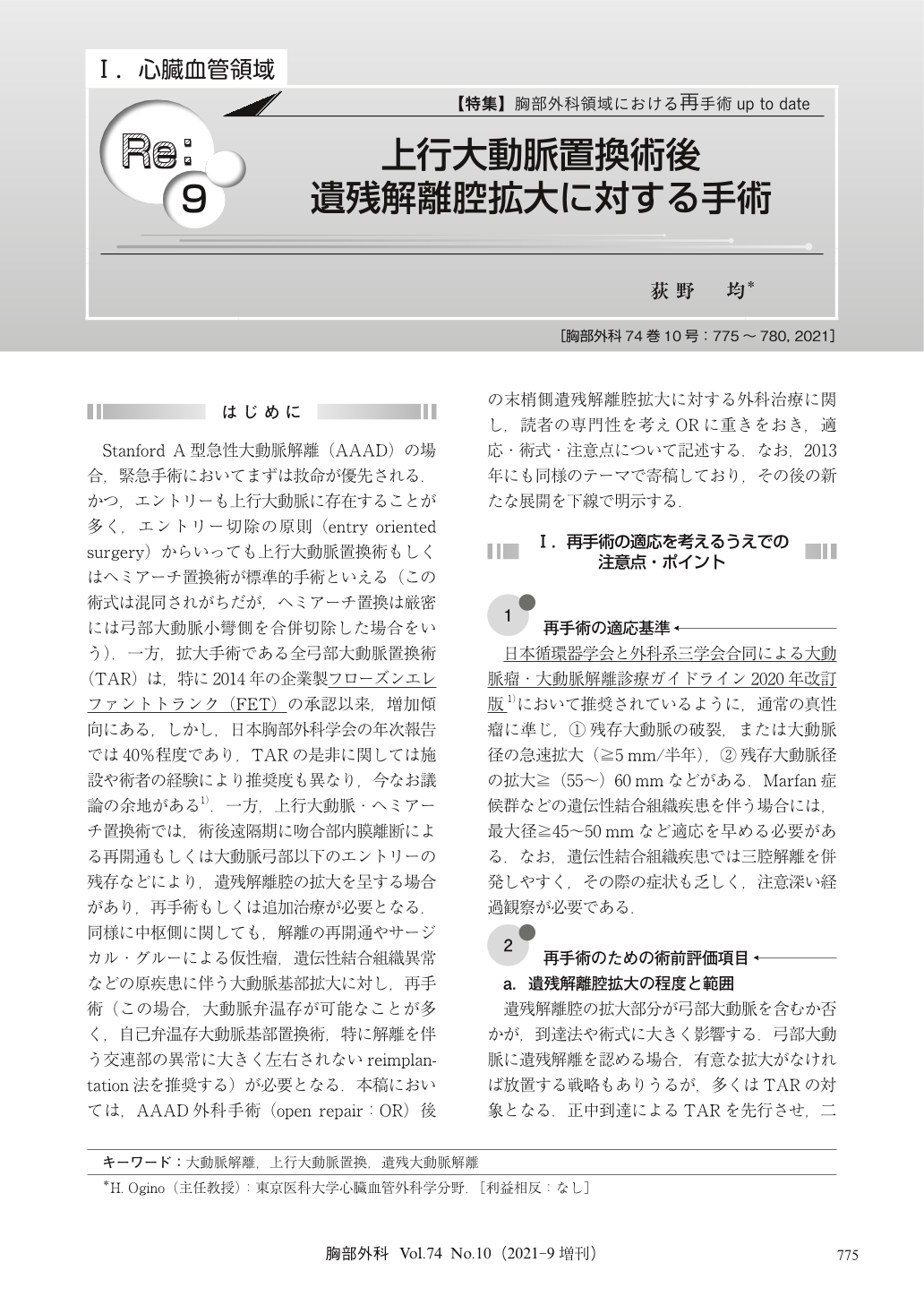Japanese
English
- 有料閲覧
- Abstract 文献概要
- 1ページ目 Look Inside
- 参考文献 Reference
Stanford A型急性大動脈解離(AAAD)の場合,緊急手術においてまずは救命が優先される.かつ,エントリーも上行大動脈に存在することが多く,エントリー切除の原則(entry oriented surgery)からいっても上行大動脈置換術もしくはヘミアーチ置換術が標準的手術といえる(この術式は混同されがちだが,ヘミアーチ置換は厳密には弓部大動脈小彎側を合併切除した場合をいう).一方,拡大手術である全弓部大動脈置換術(TAR)は,特に2014年の企業製フローズンエレファントトランク(FET)の承認以来,増加傾向にある,しかし,日本胸部外科学会の年次報告では40%程度であり,TARの是非に関しては施設や術者の経験により推奨度も異なり,今なお議論の余地がある1).一方,上行大動脈・ヘミアーチ置換術では,術後遠隔期に吻合部内膜離断による再開通もしくは大動脈弓部以下のエントリーの残存などにより,遺残解離腔の拡大を呈する場合があり,再手術もしくは追加治療が必要となる.同様に中枢側に関しても,解離の再開通やサージカル・グルーによる仮性瘤,遺伝性結合組織異常などの原疾患に伴う大動脈基部拡大に対し,再手術(この場合,大動脈弁温存が可能なことが多く,自己弁温存大動脈基部置換術,特に解離を伴う交連部の異常に大きく左右されないreimplantation法を推奨する)が必要となる.本稿においては,AAAD外科手術(open repair:OR)後の末梢側遺残解離腔拡大に対する外科治療に関し,読者の専門性を考えORに重きをおき,適応・術式・注意点について記述する.なお,2013年にも同様のテーマで寄稿しており,その後の新たな展開を下線で明示する.
Redo or repetitive surgeries for residual distal dissection after the limited proximal aortic repair for Stanford type A acute aortic dissection remains challenging. Depending on targeted aortic segments, the strategy including a median or lateral approach and one or two-staged repairs would be determined with careful consideration for patient’s age and conditions of the brain, heart, lung, liver, and kidney. Given the aortic arch involved, for young and low-risk patients, an aggressive one-stage repair of the entire arch to descending aorta through a left thoracotomy is attempted. In particular, with our left antero-axillary approach, it would be much easier with a better surgical field from the ascending aorta to the descending/thoracoabdominal aortic segments. Meanwhile, two-staged repairs are more beneficial for elderly higher-risk patients, which consists of the first total arch replacement (TAR) with elephant trunk (ET) through a median sternotomy followed secondly by an open descending/thoracoabdominal aortic repair through a left thoracotomy or by less-invasive thoracic endovascular aortic repair. In additions, TAR with a frozen ET (FET) has been a new option for downstream aortic remodeling. Consequently, in the initial repair, TAR with FET or ET has been more aggressively performed to prevent such troublesome behaviors of the residual aortic dissection.

© Nankodo Co., Ltd., 2021


